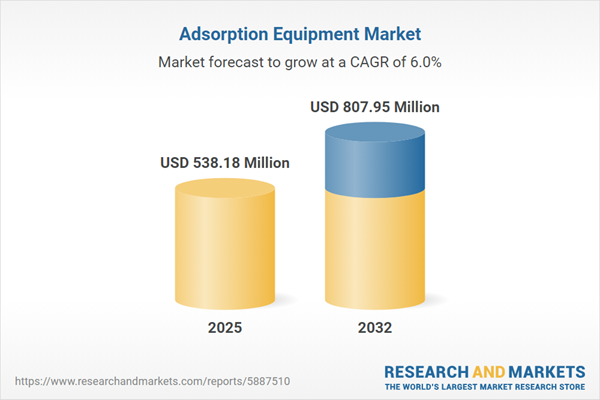Speak directly to the analyst to clarify any post sales queries you may have.
The adsorption equipment market is undergoing rapid structural and technological transformation, driven by evolving industrial demands and the global push for sustainable solutions. Senior decision-makers navigating this landscape must address operational efficiency, compliance, and resiliency within increasingly complex regulatory and supply environments.
Market Snapshot: Global Adsorption Equipment Market Overview
The adsorption equipment market grew from USD 507.11 million in 2024 to USD 538.18 million in 2025. It is expected to continue expanding at a CAGR of 5.99%, reaching USD 807.95 million by 2032. This growth trajectory reflects the sector’s critical role in addressing air and water purification, industrial emissions treatment, and sustainable resource management. Companies worldwide are strengthening their capabilities to ensure compliance and enhance system performance amid shifting regulatory and technology paradigms.
Scope & Segmentation of the Adsorption Equipment Market
This report analyses the adsorption equipment sector by application, adsorbent type, technology, process, end-user industry, and region. The study highlights key areas essential to strategic planning:
- Application: Air Purification (Industrial, Residential), Food & Beverage Processing, Gas Separation (Carbon Dioxide Removal, Hydrogen Recovery, Nitrogen Generation, Oxygen Generation), Medical Gas Purification, Water Treatment (Drinking, Industrial Effluent, Wastewater).
- Adsorbent Types: Activated Carbon, Metal Organic Frameworks, Silica Gel, Zeolites.
- Technologies: Electric Swing Adsorption, Pressure Swing Adsorption, Temperature Swing Adsorption, Vacuum Swing Adsorption.
- Processes: Gas, Liquid.
- End-User Industries: Chemical & Petrochemical, Electronics, Food & Beverage, Oil & Gas, Pharmaceuticals, Water & Wastewater Treatment.
- Regions: Americas (North and Latin America), Europe, Middle East & Africa, Asia-Pacific (including China, India, Japan, Australia, South Korea, Southeast Asia, and others).
Key Takeaways for Senior Decision-Makers
- Adoption of advanced adsorbents such as metal organic frameworks is transforming selectivity and system durability, increasing solution value across demanding industrial applications.
- Emerging integration of digital process simulation and monitoring platforms is enabling real-time operational optimization and reducing unplanned downtime.
- Regulatory tightening, especially in air and water quality, means decision-makers must adapt strategies to address both operational risk and new compliance requirements.
- Collaboration between equipment vendors and adsorbent providers accelerates innovation, while joint ventures and acquisitions are redefining competitive positions in key markets.
- Service-centric offerings, including predictive maintenance and performance-based contracts, are increasingly valued by end users to extend asset life and control costs.
- Regional market characteristics demand tailored go-to-market approaches. For example, Asia-Pacific's industrial expansion drives volume demand, while the Americas prioritize customization and rapid deployment.
Tariff Impact: Evolving Cost Structures in 2025
The introduction of new United States tariffs in 2025 has reshaped global procurement and supply strategies for adsorption equipment suppliers. Core components and specialized adsorbents frequently sourced from Asia and Europe have become more costly, leading manufacturers to diversify their sourcing and accelerate localized production. This adjustment has prompted a transition to supply chain resilience models and reinforced the importance of service-led differentiation to maintain margins and customer satisfaction.
Methodology & Data Sources
This market study applies a rigorous methodology, integrating interviews with industry leaders, engineers, and end users. It combines primary research with secondary reviews of technical papers, patent filings, regulatory documents, and supplier shipment data. Quantitative analyses are supported by scenario modeling and expert peer review to ensure insight reliability.
The Primary Keyword: Adsorption Equipment Market
Why This Report Matters
- Enables strategic planning with actionable insights on technology, application trends, and regulatory impacts for senior leaders.
- Helps assess and benchmark competitors, revealing how leading companies leverage innovation, digital solutions, and service models within global and regional contexts.
- Supports investment and procurement decisions by offering granular segmentation and regional analysis that align with business growth and risk mitigation objectives.
Conclusion
The adsorption equipment market is transforming through material advances, digital integration, and shifting regulation. Engaging with innovation and aligning strategies to regional and industrial dynamics will be essential for driving operational performance and sustaining growth in this evolving sector.
Additional Product Information:
- Purchase of this report includes 1 year online access with quarterly updates.
- This report can be updated on request. Please contact our Customer Experience team using the Ask a Question widget on our website.
Table of Contents
3. Executive Summary
4. Market Overview
7. Cumulative Impact of Artificial Intelligence 2025
Companies Mentioned
The companies profiled in this Adsorption Equipment market report include:- Veolia Environnement S.A
- Suez S.A
- Evoqua Water Technologies Corp
- DuPont de Nemours, Inc.
- Kuraray Co., Ltd.
- Cabot Corporation
- Arkema S.A.
- Mitsubishi Gas Chemical Company, Inc.
- Ingevity Corporation
- Xylem Inc.
Table Information
| Report Attribute | Details |
|---|---|
| No. of Pages | 182 |
| Published | October 2025 |
| Forecast Period | 2025 - 2032 |
| Estimated Market Value ( USD | $ 538.18 Million |
| Forecasted Market Value ( USD | $ 807.95 Million |
| Compound Annual Growth Rate | 5.9% |
| Regions Covered | Global |
| No. of Companies Mentioned | 11 |









